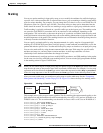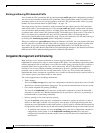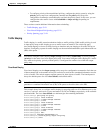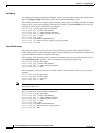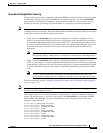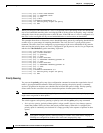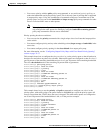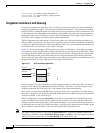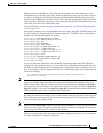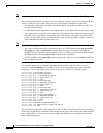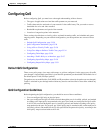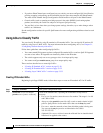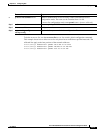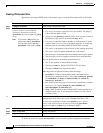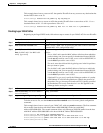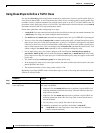
33-27
Cisco ME 3400 Ethernet Access Switch Software Configuration Guide
OL-9639-06
Chapter 33 Configuring QoS
Understanding QoS
Beginning with Cisco IOS Release 12.2(25)SE, the switch supports up to three unique queue-limit
configurations across all output policy maps. Within an output policy map, only four queues (classes)
are allowed, including the class default. Each queue has three thresholds defined. Only three unique
threshold value configurations are allowed on the switch. However, multiple policy maps can share the
same queue-limits. When two policy maps a share queue-limit configuration, all threshold values must
be the same for all the classes in both policy maps.
For more information, see the “Configuring Output Policy Maps with Class-Based-Weighted-Queuing”
section on page 33-53.
This example configures class A to match DSCP values and a policy map, PM1. The DSCP values of 30
and 50 are mapped to unique thresholds (32 and 64, respectively). The DSCP values of 40 and 60 are
mapped to the maximum threshold of 112 packets.
Switch(config)# class-map match-any classA
Switch(config-cmap)# match ip dscp 30 40 50 60
Switch(config-cmap)# exit
Switch(config)# policy-map PM1
Switch(config-pmap)# class classA
Switch(config-pmap-c)# bandwidth percent 50
Switch(config-pmap-c)# queue-limit 112
Switch(config-pmap-c)# queue-limit dscp 30 32
Switch(config-pmap-c)# queue-limit dscp 50 64
Switch(config-pmap-c)# exit
Switch(config-pmap)# exit
Switch(config)# interface gigabitethernet 0/1
Switch(config-if)# service-policy output PM1
Switch(config-if)# exit
You can use these same queue-limit values in multiple output policy maps on the switch. However,
changing one of the queue-limit values in a class creates a new, unique queue-limit configuration. You
can attach only three unique queue-limit configurations in output policy maps to interfaces at any one
time. If you attempt to attach an output policy map with a fourth unique queue-limit configuration, you
see this error message:
QoS: Configuration failed. Maximum number of allowable unique queue-limit
configurations exceeded.
Note When you configure a queue limit for a class in an output policy map, all other output policy maps must
use the same qualifier type and qualifier value format. Only the queue-limit threshold values can be
different. For example, when you configure class A queue limit thresholds for dscp 30 and dscp 50 in
policy map PM1, and you configure class A queue limits in policy map PM2, you must use dscp 30 and
dscp 50 as qualifiers. You cannot use dscp 20 and dscp 40. The threshold values can be different, but
different threshold values creates a new queue-limit configuration.
By default, the total amount of buffer space is divided equally among all ports and all queues per port,
which is adequate for many applications. You can decrease the queue size for latency-sensitive traffic or
increase the queue size for bursty traffic.
Note When you use the queue-limit command to configure queue thresholds for a class, the WTD thresholds
must be less than or equal to the queue maximum threshold. A queue size configured with no qualifier
must be larger than any queue sizes configured with qualifiers.
When you configure queue limit, the range for the number of packets is from 16 to 544, in multiples of
16, where each packet is a fixed unit of 256 bytes.



